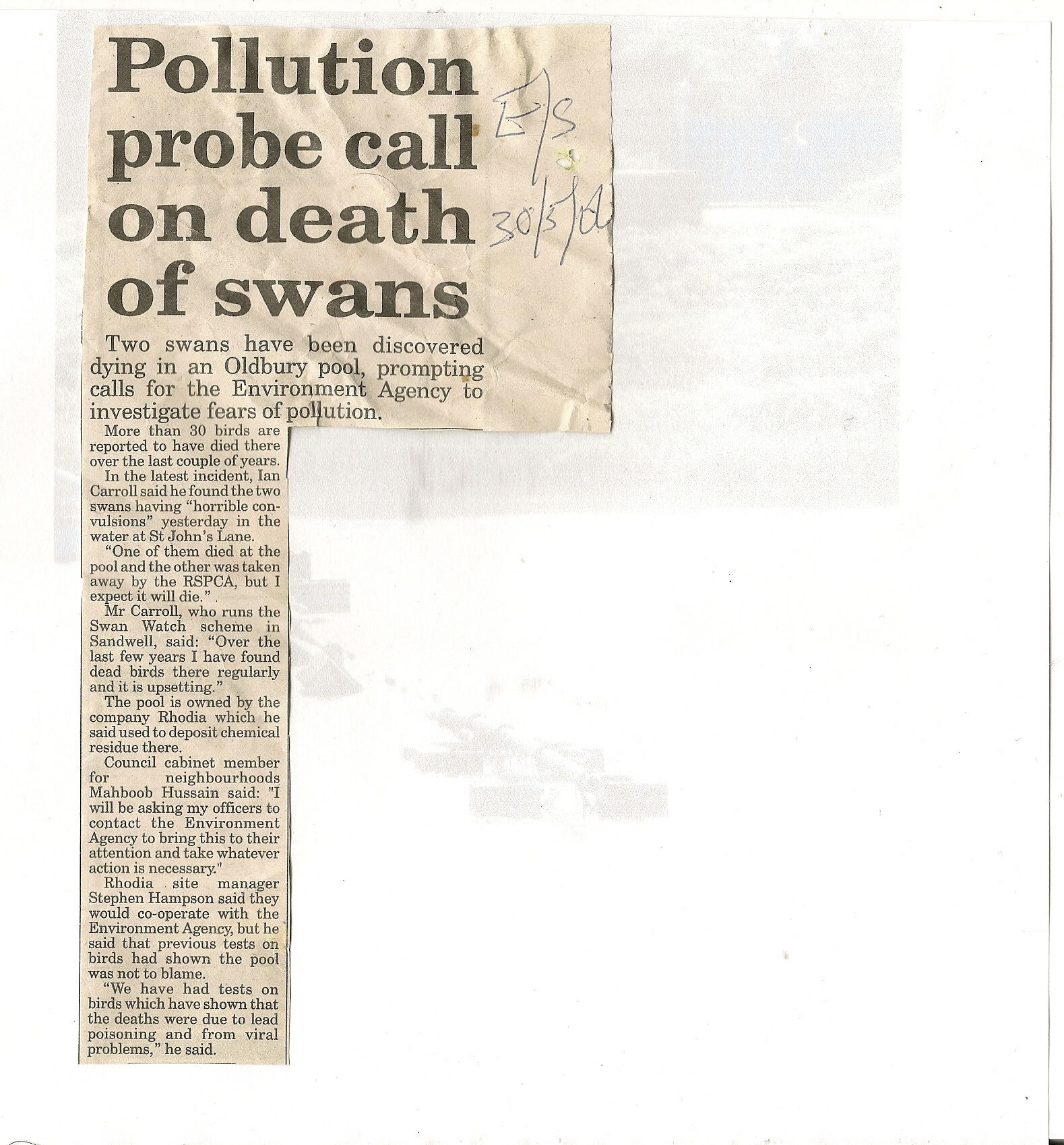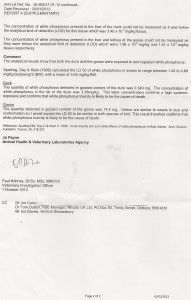POST MORTEM REPORTS AND THE VLA- NOW KNOWN AS AHVLA
The majority of birds seen dead on the pool have not been retrieved due to inaccessibility issues, as Rhodia hold the keys to this closed site. Recovery is entirely dependent on them opening the gates and in many cases putting a boat on the water to pick up carcasses which drift towards the far North embankment. Cost issues have also prevented birds from being post mortemed privately and the majority of examinations have been carried out by the Veterinary Laboratories Agency, (VLA), a part of DEFRA as part of the wild bird monitoring scheme. The VLA merged with Animal Health in April 2011 to become the AHVLA.
The VLA had no knowledge of the white phosphorus waste in the rattlechain lagoon sediments prior to being told about it by us. We also had to inform them of the toxic effects of white phosphorus on wildfowl after googling the extensive US studies at Eagle River Flats.
It should be noted that on submitting birds for post mortem in the early part of the 2000’s, the VLA were NOT informed by Rhodia during initial post mortem analysis of white phosphorus being present in the rattlechain sediments, nor the substantial chances of this highly toxic substance being the fairly obvious link in their deaths. Nor were they informed of the potential health and safety risks of handling such birds by Rhodia. This is confirmed by Ian Davies from the VLA in a letter dated 13th August 2009
“I have not been able to contact all staff at VLA involved with investigation of mortality of birds at Rattlechain pool, but to the best of my knowledge, VLA were not aware of the presence of white phosphorus until advised by yourself.”
Following our disclosure to them about the potentially toxic and dangerous chemicals on and within carcasses he reveals:
“Health and safety aspects have been adopted to minimise any potential exposure to white phosphorus when carrying out post-mortem examination of a carcase. These have included carrying out examinations in a safety cabinet, wearing appropriate protective clothing and placing gizzard unopened into a container for future potential laboratory analysis.”
Many tests carried out on carcasses were part of the organisations remit and some offered suggestions of cause of death such as “starvation”. These conclusions must now be largely diregarded due to the unnatural nature of this chemical having not been tested for within these accutely deceased and healthy looking birds.
Ian Davies was asked what experience VLA staff had in dealing with white phosphorus poisoned birds, given that the chemical was banned as a rat poison in the 1960’s and that this pool is probably unique in the UK- ergo- there are probably very few people in this country who have ever carried out any analysis on wildfowl being poisoned by this chemical; this is quite an important point when official statements on “cause of death” are being recorded or mis-recorded.
“I am not aware that any of the VLA staff who carried out post-mortem examinations on these birds have experience of poisoning with white phosphorus. However VLA veterinary staff are trained in post-mortem techniques and regularly carry out post-mortem examinations on a range of species.”
It is therefore unfortunate that the VLA staffs lack of knowledge concerning poisoning of this type has given way to mis-diagnosis of “cause of death”, based on incidental or concurrent findings that they have been able to test for.
The adequacy of their post mortem reports predating the known toxic exposure to white phosphorus that was obviously able to and were taking place, are highly questionable. The fact that their laboratories are unable to test for white phosphorus- meaning that no definitive diagnosis would ever have been made by them concerning this chemical should also be noted given that Rhodia were paying them to conduct post mortems that they knew would detect nothing to link it to their toxic waste. To date only twelve of the dozens of dead wildfowl seen dead on Rattlechain lagoon have been tested for toxic white phosphorus, all finding it!
A discussion of two such examples of mis-diagnosis by the VLA are given below.
MISLEADING POST MORTEMS
Vla ref no 26-B0063-04-06, examined a dead swan from the pool which was collected by DEFRA as part of the avian influenza scheme.
The swan is described as a “12kg adult male” that was concluded to have died from “lead poisoning” even though there was no gross evidence of cause of death.
We take issue with these findings for the following reasons.
- The swan submitted was not an “adult” but a juvenile second year bird
- It had been partially eaten but it’s weight was a healthy one even for a bird that had supposedly died from lead poisoning (LEAD POISONING IN WLDFOWL LEADS TO FAT AND MUSCLE DEPRECIATION)
- A chronically lead poisoned bird would not weigh in the region of 12kg
- The bird had been identified by its clearly visible leg ring on a nearby canal just 48 hours earlier so was capable of recent flight
- It was feeding and upending on the pool on willow moss without any clinical signs of lead poisoning just 24 hours before being found dead- lead poisoned swans usually show signs of limber neck and lose weight quite rapidly over a period of several weeks.
The inconsistencies apparent here, lead one to wonder if this was indeed a post mortem report of the bird that was taken from this site.
Vla ref no 27-B0449-05-06 2 juvenile mute swans.
These birds received an extremely limited post mortem of little or no value, and the finding “death was probably due to starvation in Richard Irvines’s opinion” is largely irrelevant.
- These birds were feeding and upending 12 hours before death showing no apparent ill health effects
- A large quantity of willow moss is available in the pool which they were accessing, as evidenced in the URS report on bird deterrence commissioned by Rhodia.
- Their weights of 8kg and 10kg do not suggest starving to death, but are well within the range of normal weights for healthy birds of this age.
- Sparling et al noted the following gross pathology and histopathology in mute swans.
“Swans dosed with p4 lost from 2-15% of their body weight within a week whereas control birds demonstrated no net loss of weight. Weight loss is a frequent sign of P4 toxicity (Sparling et al. 1997; Sparling and Federoff 1997) and is probably due to malaise and inappetance during the period of actual exposure in that birds quickly regained body weight after dosing in repeated dose experiments (Sparling unpublished data.)Clearly in such situations, the longer birds are exposed to toxins that reduce appeatite, the greater the degree of weight loss. Because swans were acutely dosed their weight loss was relatively small.”
- Taking these findings into account it should be noted that both birds simultaneously started showing the same white phosphorus associated clinical signs at the same time suggesting acute exposure. One died in my hands after pulling it from the water, the other on the way to Barnes Hill Animal hospital after being collected by the RSPCA. Convulsions in this bird were continuing in the van on route to the centre. NB. The RSPCA staff were also therefore unknowingly exposed to sediments on the swan that could have contained white phosphorus as well as contamination to facilities at the centre.
- It is unlikely that any bird would die from “starvation” in the heavily urbanised West Midlands, and not on a pool rich in flora- unnaturally so due to the high levels of phosphate in the pool that Rhodia’s apologists keep claiming is present in the sediments. Additionally these birds would likely have found both natural and human fed food when on the canal just 48 hours earlier.
These post mortem findings, erroneous and unsubstantiated by “direct evidence” and contrary to direct observation, were unfortunately taken at face value by the likes of the Environment Agency- who did nothing based on the “findings” of another unconnected agency making pronouncements.
When swan watch tried to get regulators to take this issue seriously and investigate the obvious source of the birds’ deaths -i.e white phosphorus poisoning, they were still unwilling to explore the issue with the seriousness that it deserved. Below are the comments of Steve Morley, “It therefore seems unlikely that the lagoon contributed to the deaths….. the reality is that the lagoon was not intended for wildlife.”
He then goes on to blame anglers for the death of one of the swans, in the hope that we would go off cursing obscenities about the activity to distract attention away from his chemical company mates most likely to distract attention away from the failed quango regulator that is “creating a better place”
Reports of these deaths and subsequent “post mortems” were also reported in the local press at the time- before we knew of the definative link between the toxic sediment and the birds’ deaths. The following article appeared in the 30/5/06 edition of The Express and Star concerning the two juvenile swans refered to above. “Pollution probe call on death of swans.”
- The “fears of pollution” were fairly obvious. The EA and Rhodia knew that the pool was polluted with toxic hazardous waste- but are we to really believe that they did not make any link- yet expected that one would be made by a post mortem report where this chemical could not possibly have been detected.
- As for Sandwell council- well all we can say there is their contribution to this affair has always been rubbish.
- The pool was to blame Steve Hampson- and you always knew that didn’t you.
Evidence of the symptoms being exhibited by dying swans at Rattlechain was finally captured on film by myself in 2008, thus giving indisputable evidence as to the unnatural way in which birds were dying here just hours after landing on the pool. Some of the footage was shown on a report on BBC Midlands Today. A further swan showing the same clinical signs was recorded in 2009. These recordings happened only by the chance of seeing these ailing birds in difficulties, and by the experience of the recorder in being able to identify the specific early clinical signs.
Below are some VLA post mortem reports which confirm systemic exposure from white phosphorus after testing for white phosphorus. Click to view.
AND TO ALL THOSE WHO TRIED TO BLAME IT ON ANYTHING ELSE OTHER THAN A CHEMICAL COMPANY BUSINESS POLLUTER WHO WERE TO BLAME, MAY YOU HANG YOUR HEADS IN SHAME FROM INCOMPETENCE OR DECEIT; WE TOLD YOU SO.











